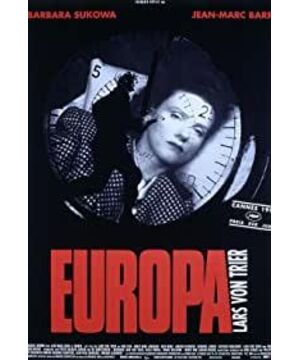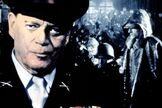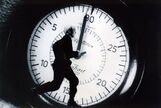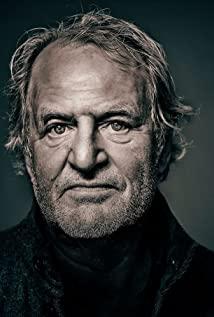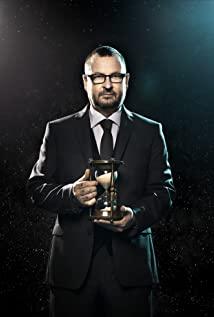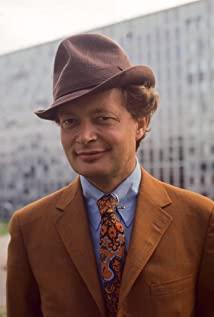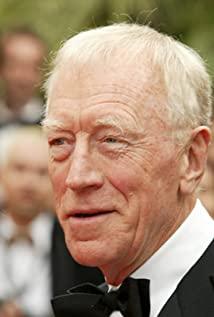In 1991, "Europa Express" participated in the premiere of the 44th Cannes Film Festival. In the same year, the Hollywood special effects blockbuster "Terminator 2" was released and achieved worldwide success. The success of "Terminator 2" represented the computer The era of digital special effects replacing traditional photographic special effects has arrived, and after Europa Express, Lars von Trier's "European Trilogy" will come to an end. Lars von Trier at this time "has a fetish preference for film technology", and the equipment provided by the film school can create "endless possibilities", "to be able to use them to have a go is the best exciting thing." ("Las Von Trier's Movie Kingdom"), but unlike "Terminator 2", which has extensive application of digital special effects technology, "Europa Express" focuses on traditional photography stunts, and screen compositing is the most important one of traditional photography stunts. Technology became the focus of Lars von Trier, and the film was a surprise as soon as it debuted in Cannes, and the film immediately won the Jury Prize and the Supreme Technical Committee Award at the 44th Cannes Film Festival. Just as "Red Desert" was once named "the first color film in film history" by "Cinebook" for its superb use of color, "Europa Express" can be regarded as the first screen composite film in film history in a sense. .
Screen synthesis is a self-covering visual effect that combines the actor's performance or model with the pre-filmed background data. According to the different relative positions of projection equipment and various parts of the scene, it can be divided into two categories: "back screen synthesis" and "front screen synthesis". The pioneer of screen synthesis was Norman O. Down. When he made the film "The Wanderer" in 1913, he envisaged using the rear projection method to shoot some of the special effects in the film. Finally, in 1930, this technology was matured and perfected, and then it was introduced and used by Hollywood. It quickly became one of the most widely used special effects photography techniques in Hollywood. Because of the screen synthesis technology, the exterior shots can be moved into the studio for shooting, and it can be used for the same period of recording. Good conditions, improve production efficiency and save money, but the main function of screen synthesis technology in Hollywood movies is as a substitute for grand location scenes or locations that cannot be completed under realistic conditions. Hitchcock also has a lot in "The Birds". The use of screen synthesis technology, but Hitchcock's point of view on technology represents the mainstream creative position in Hollywood, technology should be hidden under the story, not perceived by the audience.
In "Europa Express", the audience can easily recognize that the whole film uses a total of 27 screen composites. We can learn from Lars Von Trier's attitude towards pushing and pulling the shots in "Criminals", and understand the director's attitude towards the film. Techniques include a point of view on screen compositing "The reason I only used push-pulls and lifts and not pans in Criminal is because I don't want to hide anything. A push-pull is a big obvious move. , but in most American films, the directors try to hide the push-pull shot. For them, the push-pull shot is just a way to easily move from point A to point B, so it has to be fake. However, I try not to hide this. If I do, I feel like I'm cheating." The director obviously wants his technical means to be perceived by the audience, and if the audience can perceive the technology itself, the technology should give the audience enough visual impact or rational thinking.
Film semiotics is one of the most important theories in modern film studies. Its appearance and development indicate the origin and trend of modern film theory. Montage theory and Bazin's theory of realism established the existence of film as an independent art form. Compared with other art forms, films have unique linguistic and aesthetic characteristics. Semiotic theory is a further development of film theory. It explores the more specific ideographic issues of film language. Film language has its own ideographic system. Although it uses lenses to present and reflect the objective world and daily life, its language is different from natural language. The language of art. It is for this reason that films have aesthetic value and are able to communicate emotionally and cognitively with the audience.
"Europa Express" sets the narrative background in Germany just after World War II. The male protagonist is a young German-American borrower Kessler, who returns to the motherland he has never set foot in after World War II. He was originally a pacifist and idealist who wanted to see the people of postwar Europe in a neutral way. Unexpectedly, his uncle arranged for Kessler to be a conductor on a train, which gave him the opportunity to go deep into Europe and listen to various voices, thus exposing the falsehood of peace slogans and humanitarianism. And he fell in love with the railway company boss daughter, who is also a supporter of Nazism, which made him fall into the dilemma of love and conscience. "Europa Express" tells a brutal story, and the whole film is full of gloomy and grim undertones. The director uses screen synthesis technology to produce a dazzling, magical and realistic color. The visual effects and rich connotations provide the audience with a wide interpretation space, and also endow the film with three-dimensional and multi-layered structural features of the ideographic system. From the perspective of film semiotics, the author analyzes the ideographic structure of screen synthesis technology in "Europa Express" from the perspective of emotional symbols and symbolic symbols.
1. Emotional symbols
The film "Europa Express" is relatively successful in fully mobilizing the audience's emotions and making it intervene in the aesthetic re-creation of the film. Since the "signifier" and "designated" in the first-level symbols of the film are the same, the information received by the audience through the screen clearly expresses its "designated". According to Christian Metz's film ontology, "signifier" and "signified" constitute the "signifier" in the secondary symbol system, and emotion is the most important "signifier" # Therefore, the film shows the audience It is about specific things and characters, but it is not simply presented, but these aesthetic objects carry clear and rich emotions, and these emotions are realized through the inner experience of the audience. Every film has a universal and Unique emotional expression, the former provides the basis for the interaction between the film and the audience, and the latter determines the film's own artistic style. The same goes for the emoji composition of Europa Express.
The emotions expressed in the film are rich, and the symbols showing emotions are also varied. In the film, both love and conscience have been strongly expressed. These people's normal feelings make it easy for the audience to enter the emotional atmosphere of the film. For film semiotics, various ideographic symbols have relatively independent meanings, and the generation and changes of various emotions of the audience are closely related to the narrative content, the fate of the protagonist, the color and composition of the picture, and various sound elements. The film uses screen synthesis technology to fully mobilize these elements to achieve the audience's emotional understanding and real emotional experience of the film's characters.
The story of "Europa Express" is not complicated. Kessler, a German-American, defected to his German uncle shortly after the end of World War II. He immediately got a job as a conductor and met a mysterious and charming female passenger from the train. , her name is Katherina, the daughter of Max, the owner of the transportation company, and then Kessler received Katherina's dinner invitation. Kessler went to the dinner and gradually got to know her family. The relationship between the two also heated up sharply. A week later , the two meet again, but Kessler's father committed suicide in the bathroom because he was involved in the investigation of the German underground resistance organization. The grief-stricken Katherina and Kessler fell in love. A year later, the two were married, but Soon, a bigger change awaits them. On the day Kessler takes the conductor's exam, Kessler is threatened by the German underground resistance, asking him to blow up the Europa Express, otherwise, his wife will be killed and forced. Due to human affection, Kessler planted a bomb under the car. Due to his conscience, Kessler did not activate the bomb, but the subsequent truth made Kessler lose his mind. Katherina was arrested by the American troops stationed in Germany. In fact, Katherina is a member of the German underground resistance, and her father and brother's deaths are related to her. Kessler has to deal with the tyrannical passengers on the one hand, the demanding train conductor exam on the other hand, and the beloved wife. Deceived by himself, an angry Kessler eventually collapses, and he sets off a bomb that blows up the Europa train, drowning himself in the water.
When the young American Kessler, led by his German uncle, saw the Europa Express for the first time, Kessler at that time was shocked by this behemoth, the door slowly opened, and more than 40 child laborers pulled the cable to slowly pull the train out , the camera slowly rises, the scene is extremely spectacular, and the appearance of the train is extremely ritualized, but this train is built on an oppressive order, and the director has hinted at the fascist meaning of this Europa Express from the very beginning. It was pulled out like Noah's Ark, with a neat central composition and a low-angle elevation shot. It can be said that the Europa Express appeared in a state of admiration by thousands of people. As an outsider, Kessler must have a great deterrent power in the face of the train. The director used screen synthesis here. The foreground is a close-up of Kessler's expression after color printing, and the background is a circle of black and white primary colors. moon. The conversion of black and white and color gave the audience a great visual impact, and also represented Kessler's psychological activities at that time.
When Kessler first saw Katherina, the heroine of the film, he was overwhelmed by her graceful temperament and made the bed for her diligently. The two then started a lighthearted conversation. When Kessler met the woman he liked for the first time in a foreign country, and as the film's most important emotional clue, the handling of this paragraph is naturally very important. The director once again used screen compositing techniques, with a close-up of Katherina in color developed in the foreground, and a close-up of Kessler from the original black and white painting in the background. Color has ambiguous emotional color here.
When Kessler first learned about the German Nazi underground resistance organization "Wolfman", he fell into thinking about the werewolf. The background changed from the carriage to the word WERWOLF. The screen composition here shows Kessler's deep concern for the werewolf organization. And doubts, and the composition of the picture, Kessler is in the corner of the picture, Werwolf seems to be swallowing him, and the same composition treatment also appeared on a honeymoon trip between Kessler and Kesslina, Kessler married him The beautiful Catharina felt deeply that she was in a dangerous situation. The background was a huge head of Catharina. In front of Catharina, Kessler curled up in a corner, looking helpless and insignificant. One is a wonderful performance of the relationship between the two, and Kessler has never been able to escape Katherina's manipulation of his fate.
2. Symbols
The so-called symbol refers to the overall semantic field of a social pan-text formed by people relying on cultural customs. For example, the red rose represents love, and the ring worn on the ring finger symbolizes marriage. Symbols are combined with the specific film context, so that the purpose expressed by the director can be implicitly realized, so that the audience can reach a tacit understanding with the film and produce an aesthetic identity.
As the final chapter of director Lars von Trier's "European Trilogy", "Europa Express" is undoubtedly closely related to the first two films. First of all, it defines a major public issue in Europe and China: crime. , the plague, the reconstruction of Europe after World War II, and the formal unity is hypnotism. The trilogy has a strong expression on hypnosis, while the hypnosis in the first two films is only an important element of the film, while in "Europa Express", hypnosis is the symbol of the whole film, and the director symbolizes the whole film as a scene Dreams, and hypnosis is the train to dreams.
The French film director and film theorist René Claire once said, "Please pay attention to the peculiar mental state of the movie audience. The dark auditorium, the hypnotic effect of the music, the silent shadows flashing on the bright screen, all these Together they send the audience into a drowsy state where what we see before our eyes is as hypnotic as what we see in real sleep."
(1) The transition of the dream.
The time-space transition of the characters in the dream often jumps, but the feeling is indeed continuous. The characters do not have any interruptions in emotions or situations. From one time-space to another time-space is not a jump but an extension. The conventional time-space editing method will inevitably cause emotions. Interruption, in the classic Hollywood editing method, if there is a big change in time and space between the two scenes before and after, it must be clearly expressed in editing, otherwise it will cause the audience to feel confused. However, if you follow the feeling of dreams, this kind of confusion is exactly what the director needs. The screen synthesis helped the director realize the confusion of the dream.
Horrified after Kessler witnessed the "werewolf" children gunning down their own German compatriots, the director did not give the audience too much time to think, but immediately switched to Katharine after the camera was aimed at Kessler At home, Kessler transferred directly from the train carriage to Katherina's home a week later.
The transition strategy is that the characters in the foreground are synthesized on the screen, and the projection content of the background is changed to create a space-time transition without obvious editing points. Just like the editing strategy of dream scenes, people always feel that they are transitioning from one scene to the next scene.
(2) The distance between the real and the illusory
According to Hollywood's point of view, technology can never override the story. The audience is first addicted to the story. Technology is only a means to make the audience addicted to it. If the technology can be perceived, the audience will withdraw from the story. An unconscious alienation effect, the alienation effect will make the audience unable to appreciate the story 100%, but in the dream principle, the dreamer does not completely believe in the authenticity of the dream, and the film style that seems to be true and illusory is the reality of the dream. Experience, therefore, the alienation effect becomes an important means for the director to create this style.
Lars von Trier once said that "the connection between Max von Seedorf's hypnotic narration and the film's overture is the same as the chapter titles in "Breaking the Waves," which reproduce the An assumed, or rather, God's point of view." Max von Sydow's voice is repressed, low, and full of unquestionable majesty, which constitutes a natural paternal hypnosis form. Hypnosis is not only the atmosphere of the story that the film tries to present, but also the structural form of the story. There are ten hypnotic places in the whole film. There are six places where hypnotic passwords really appear. These six places structure the film into six units. The narrative structure of chapters in this literary form makes the audience have a cautious attitude towards the film. Under the effect of "hypnosis", the audience cannot understand which is real and which is unreal, and this is the huge symbol of the whole film.
To sum up, after "Europa Express", Lars von Trier began to adjust the way of filming. After "Hospital" successfully tried hand-held photography, he announced the DOGMA95 manifesto at the Cannes Film Festival, which clearly stated that no film should be included in the film. Film special effects appeared. After that, Lars von Trier focused more on the script structure and actor's performance style. With the development of Hollywood CG film technology, screen synthesis technology has gradually been eliminated. , replaced by green screen keying technology, screen compositing represents one of the highest technical means of special effects in the classical Hollywood period, and "Europa Express" also represents the highest achievement of the films shot in the period of Lars von Trier's technical supremacy, which are about to be forgotten. , but worth remembering.
View more about Europa reviews


